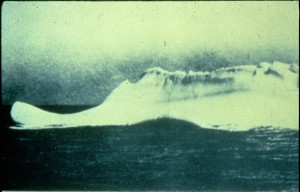The 1997 Oscar for best picture went to James Cameron’s Titanic. Kate Winslet and Leonardo DiCaprio starred as turquoise ice-hued sweethearts out for a chilly cruise across the North Atlantic in 1912. We trembled in anticipation of what we knew would happen next as they playfully dodged falling ice chunks while the bow of the ship was grazed by a towering iceberg. An ominous tearing sound accompanied the villainous iceberg’s moment on the big screen as it claimed the unsinkable RMS Titanic by punching six gashes along the ship’s hull.
There is some controversy over the exact sequence of early morning events on April 15, 1912, interwoven with speculation about what people were thinking and doing during Titanic’s last moments. “Sea ice alerts” were received on board ship during the day on April 14, 1912, although it is believed that the report closest to the time of the iceberg collision never made it to the ship’s bridge. There may have been more than one iceberg. Sea ice records from before and after the disaster confirm that there were many icebergs in the area. The 1997 blockbuster fictitiously filled in some of the blanks and gave new meaning to the futility of “rearranging the deck chairs on the Titanic” as viewers watched those deck chairs being jumbled into the sea along with everything and everyone else. But what about that bad boy iceberg?
Every drama needs a villain and the story of the Titanic certainly has one in the form of a big hunk of Arctic sea ice. The iceberg that easily punched through the Titanic’s super-chilled steel hull is estimated to have been 50 to 100 feet high and 200 to 400 feet long. Icebergs are usually three or more times bigger than the “tip of the iceberg” that is visible above the water line. Speculation is that Titanic’s bad boy came from Greenland, where large ice chunks are known to break off, or “calve,” from glaciers and float south.
Photographs do not exist of what actually happened as the ship went down that night, but two probable photographs of the culprit iceberg are found on the web site of the International Ice Patrol. The first was in the possession of ship captains of that time. The second was taken by the chief steward of the liner Prinze Adelbert the morning after the sinking because he spotted a suspicious streak of red paint near the base of an iceberg in the vicinity.

A photograph of the iceberg with which the RMS TITANIC supposedly collided on April 14, 1912 at latitude 41-46N, longitude 50-14W. The photograph was taken by a crew member of the Cable Ship MINIA. Courtesy of the U.S. Coast Guard International Ice Patrol.
From the beginning of Arctic voyages in the early 1800s, and long before the Titanic disaster, vessels had been lost or damaged due to collisions with sea ice. In the wake of the much-publicized tragedy, which highlighted the fact that the White Star Line had only supplied enough lifeboats for about half its passengers, the International Ice Patrol (IIP) was established in 1913. Currently part of the U.S. Coast Guard, the IIP works to eliminate the risk of iceberg collisions by providing information about dangerous ice and other sea hazards. It also provides general resources about icebergs and North Atlantic oceanography.
When Titanic and the iceberg collided, the ship’s hull was constructed of low-grade steel by today’s standards, which became especially brittle in cold temperatures. Improvements in ship design, materials and building techniques have resulted in vessels that are able to withstand Arctic sea temperatures. Better engineering and attention to safety details combined with recent iceberg detection technology make one wonder if a different outcome might have been achieved if the maiden voyage of the Titanic had happened in 2008. What do you think?
Classroom Extras
There are many museums and web sites dedicated to commemorating the 1,523 victims and 705 Titanic survivors, and to the science and engineering surrounding the tragedy. Have your students use available web resources to report on three possible reasons why the “unsinkable” Titanic went down. Along with the links in this article, here are resources to get you started:
The Titanic Historical Society, Inc.: The Official Website of the Titanic Historical Society, Inc., Indian Orchard, Massachusettes
Established in 1963, this is the premier source for Titanic and White Star Line information and is the original and largest Titanic society in the world. Best for teacher reference.
Encyclopedia Titanica
Crew, passengers, history, research, and discussions on Titanic-related themes. A 2006 article titled “Ice: Clear and Absent Danger” relates details of a study that investigated how far away icebergs of various sizes could be seen at night. Best for teacher reference.
Titanic: World’s Largest Museum Attraction, Branson, Missouri
Primarily focused on the Titanic film, the web site features language arts, science, geography and math classroom activities. The Titanic Buoyancy experiment demonstrates the principle behind why the ship sank.
BookMoot: Titanic
This blog post lists fiction and nonfiction children’s books about the Titanic.
This article was written by Carol Minton Morris. For more information, see the Contributors page. Email Kimberly Lightle, Principal Investigator, with any questions about the content of this site.
Copyright August 2008 – The Ohio State University. This material is based upon work supported by the National Science Foundation under Grant No. 0733024. Any opinions, findings, and conclusions or recommendations expressed in this material are those of the author(s) and do not necessarily reflect the views of the National Science Foundation. This work is licensed under an Attribution-ShareAlike 3.0 Unported Creative Commons license.

